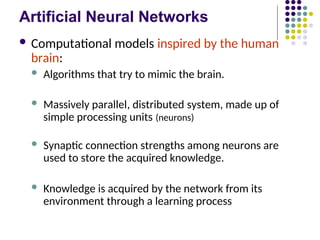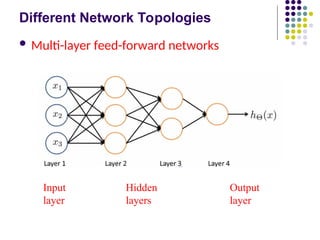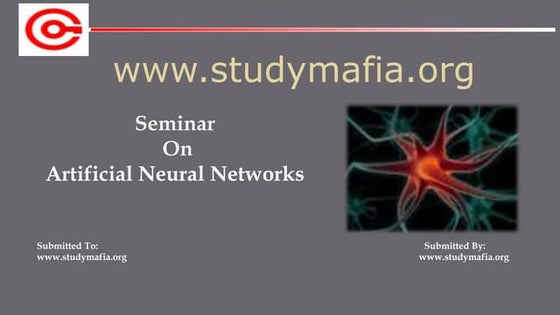Machine Learning Neural Networks Artificial Intelligence
- 1. Machine Learning Neural Networks ║▌║▌▀Żs mostly adapted from Tom Mithcell, Han and Kamber
- 2. Artificial Neural Networks ’ü¼ Computational models inspired by the human brain: ’ü¼ Algorithms that try to mimic the brain. ’ü¼ Massively parallel, distributed system, made up of simple processing units (neurons) ’ü¼ Synaptic connection strengths among neurons are used to store the acquired knowledge. ’ü¼ Knowledge is acquired by the network from its environment through a learning process
- 3. History ’ü¼ late-1800's - Neural Networks appear as an analogy to biological systems ’ü¼ 1960's and 70's ŌĆō Simple neural networks appear ’ü¼ Fall out of favor because the perceptron is not effective by itself, and there were no good algorithms for multilayer nets ’ü¼ 1986 ŌĆō Backpropagation algorithm appears ’ü¼ Neural Networks have a resurgence in popularity ’ü¼ More computationally expensive
- 4. Applications of ANNs ’ü¼ ANNs have been widely used in various domains for: ’ü¼ Pattern recognition ’ü¼ Function approximation ’ü¼ Associative memory
- 5. Properties ’ü¼ Inputs are flexible ’ü¼ any real values ’ü¼ Highly correlated or independent ’ü¼ Target function may be discrete-valued, real-valued, or vectors of discrete or real values ’ü¼ Outputs are real numbers between 0 and 1 ’ü¼ Resistant to errors in the training data ’ü¼ Long training time ’ü¼ Fast evaluation ’ü¼ The function produced can be difficult for humans to interpret
- 6. When to consider neural networks ’ü¼ Input is high-dimensional discrete or raw-valued ’ü¼ Output is discrete or real-valued ’ü¼ Output is a vector of values ’ü¼ Possibly noisy data ’ü¼ Form of target function is unknown ’ü¼ Human readability of the result is not important Examples: ’ü¼ Speech phoneme recognition ’ü¼ Image classification ’ü¼ Financial prediction
- 7. February 10, 2025 Data Mining: Concepts and Techniques 7 A Neuron (= a perceptron) ’ü¼ The n-dimensional input vector x is mapped into variable y by means of the scalar product and a nonlinear function mapping t - f weighted sum Input vector x output y Activation function weight vector w ’āź w0 w1 wn x0 x1 xn ) sign( y e For Exampl n 0 i t x w i i ’ĆŁ ’ĆĮ ’āź ’ĆĮ
- 8. Perceptron ’ü¼ Basic unit in a neural network ’ü¼ Linear separator ’ü¼ Parts ’ü¼ N inputs, x1 ... xn ’ü¼ Weights for each input, w1 ... wn ’ü¼ A bias input x0 (constant) and associated weight w0 ’ü¼ Weighted sum of inputs, y = w0x0 + w1x1 + ... + wnxn ’ü¼ A threshold function or activation function, ’ü¼i.e 1 if y > t, -1 if y <= t
- 9. Artificial Neural Networks (ANN) ’ü¼ Model is an assembly of inter-connected nodes and weighted links ’ü¼ Output node sums up each of its input value according to the weights of its links ’ü¼ Compare output node against some threshold t ’üō X1 X2 X3 Y Black box w1 t Output node Input nodes w2 w3 ) ( t x w I Y i i i ’ĆŁ ’ĆĮ ’āź Perceptron Model ) ( t x w sign Y i i i ’ĆŁ ’ĆĮ ’āź or
- 10. Types of connectivity ’ü¼ Feedforward networks ’ü¼ These compute a series of transformations ’ü¼ Typically, the first layer is the input and the last layer is the output. ’ü¼ Recurrent networks ’ü¼ These have directed cycles in their connection graph. They can have complicated dynamics. ’ü¼ More biologically realistic. hidden units output units input units
- 11. Different Network Topologies ’ü¼ Single layer feed-forward networks ’ü¼ Input layer projecting into the output layer Input Output layer layer Single layer network
- 12. Different Network Topologies ’ü¼ Multi-layer feed-forward networks ’ü¼ One or more hidden layers. Input projects only from previous layers onto a layer. Input Hidden Output layer layer layer 2-layer or 1-hidden layer fully connected network
- 13. Different Network Topologies ’ü¼ Multi-layer feed-forward networks Input Hidden Output layer layers layer
- 14. Different Network Topologies ’ü¼ Recurrent networks ’ü¼ A network with feedback, where some of its inputs are connected to some of its outputs (discrete time). Input Output layer layer Recurrent network
- 15. Algorithm for learning ANN ’ü¼ Initialize the weights (w0, w1, ŌĆ”, wk) ’ü¼ Adjust the weights in such a way that the output of ANN is consistent with class labels of training examples ’ü¼ Error function: ’ü¼ Find the weights wiŌĆÖs that minimize the above error function ’ü¼ e.g., gradient descent, backpropagation algorithm ’üø ’üØ2 ) , ( ’āź ’ĆŁ ’ĆĮ i i i i X w f Y E
- 16. Optimizing concave/convex function ’ü¼ Maximum of a concave function = minimum of a convex function Gradient ascent (concave) / Gradient descent (convex) Gradient ascent rule
- 24. Decision surface of a perceptron ’ü¼ Decision surface is a hyperplane ’ü¼ Can capture linearly separable classes ’ü¼ Non-linearly separable ’ü¼ Use a network of them
- 27. Multi-layer Networks ’ü¼ Linear units inappropriate ’ü¼ No more expressive than a single layer ’ü¼ ŌĆ× Introduce non-linearity ’ü¼ Threshold not differentiable ’ü¼ ŌĆ× Use sigmoid function
- 31. February 10, 2025 Data Mining: Concepts and Techniques 31 Backpropagation ’ü¼ Iteratively process a set of training tuples & compare the network's prediction with the actual known target value ’ü¼ For each training tuple, the weights are modified to minimize the mean squared error between the network's prediction and the actual target value ’ü¼ Modifications are made in the ŌĆ£backwardsŌĆØ direction: from the output layer, through each hidden layer down to the first hidden layer, hence ŌĆ£backpropagationŌĆØ ’ü¼ Steps ’ü¼ Initialize weights (to small random #s) and biases in the network ’ü¼ Propagate the inputs forward (by applying activation function) ’ü¼ Backpropagate the error (by updating weights and biases) ’ü¼ Terminating condition (when error is very small, etc.)
- 33. February 10, 2025 Data Mining: Concepts and Techniques 33 How A Multi-Layer Neural Network Works? ’ü¼ The inputs to the network correspond to the attributes measured for each training tuple ’ü¼ Inputs are fed simultaneously into the units making up the input layer ’ü¼ They are then weighted and fed simultaneously to a hidden layer ’ü¼ The number of hidden layers is arbitrary, although usually only one ’ü¼ The weighted outputs of the last hidden layer are input to units making up the output layer, which emits the network's prediction ’ü¼ The network is feed-forward in that none of the weights cycles back to an input unit or to an output unit of a previous layer ’ü¼ From a statistical point of view, networks perform nonlinear regression: Given enough hidden units and enough training samples, they can closely approximate any function
- 34. February 10, 2025 Data Mining: Concepts and Techniques 34 Defining a Network Topology ’ü¼ First decide the network topology: # of units in the input layer, # of hidden layers (if > 1), # of units in each hidden layer, and # of units in the output layer ’ü¼ Normalizing the input values for each attribute measured in the training tuples to [0.0ŌĆö1.0] ’ü¼ One input unit per domain value, each initialized to 0 ’ü¼ Output, if for classification and more than two classes, one output unit per class is used ’ü¼ Once a network has been trained and its accuracy is unacceptable, repeat the training process with a different network topology or a different set of initial weights
- 35. February 10, 2025 Data Mining: Concepts and Techniques 35 Backpropagation and Interpretability ’ü¼ Efficiency of backpropagation: Each epoch (one interation through the training set) takes O(|D| * w), with |D| tuples and w weights, but # of epochs can be exponential to n, the number of inputs, in the worst case ’ü¼ Rule extraction from networks: network pruning ’ü¼ Simplify the network structure by removing weighted links that have the least effect on the trained network ’ü¼ Then perform link, unit, or activation value clustering ’ü¼ The set of input and activation values are studied to derive rules describing the relationship between the input and hidden unit layers ’ü¼ Sensitivity analysis: assess the impact that a given input variable has on a network output. The knowledge gained from this analysis can be represented in rules
- 36. February 10, 2025 Data Mining: Concepts and Techniques 36 Neural Network as a Classifier ’ü¼ Weakness ’ü¼ Long training time ’ü¼ Require a number of parameters typically best determined empirically, e.g., the network topology or ŌĆ£structure.ŌĆØ ’ü¼ Poor interpretability: Difficult to interpret the symbolic meaning behind the learned weights and of ŌĆ£hidden unitsŌĆØ in the network ’ü¼ Strength ’ü¼ High tolerance to noisy data ’ü¼ Ability to classify untrained patterns ’ü¼ Well-suited for continuous-valued inputs and outputs ’ü¼ Successful on a wide array of real-world data ’ü¼ Algorithms are inherently parallel ’ü¼ Techniques have recently been developed for the extraction of rules from trained neural networks
- 38. Artificial Neural Networks (ANN) X1 X2 X3 Y 1 0 0 0 1 0 1 1 1 1 0 1 1 1 1 1 0 0 1 0 0 1 0 0 0 1 1 1 0 0 0 0 ’üō X1 X2 X3 Y Black box 0.3 0.3 0.3 t=0.4 Output node Input nodes ’ā« ’āŁ ’ā¼ ’ĆĮ ’ĆŠ ’ĆŁ ’Ć½ ’Ć½ ’ĆĮ otherwise 0 true is if 1 ) ( where ) 0 4 . 0 3 . 0 3 . 0 3 . 0 ( 3 2 1 z z I X X X I Y
- 40. February 10, 2025 Data Mining: Concepts and Techniques 40 A Multi-Layer Feed-Forward Neural Network Output layer Input layer Hidden layer Output vector Input vector: X wij ij k i i k j k j x y y w w ) ╦å ( ) ( ) ( ) 1 ( ’ĆŁ ’Ć½ ’ĆĮ ’Ć½ ’ü¼
- 41. General Structure of ANN Activation function g(Si ) Si Oi I1 I2 I3 wi1 wi2 wi3 Oi Neuron i Input Output threshold, t Input Layer Hidden Layer Output Layer x1 x2 x3 x4 x5 y Training ANN means learning the weights of the neurons

































![February 10, 2025
Data Mining: Concepts and
Techniques 34
Defining a Network Topology
’ü¼ First decide the network topology: # of units in the input
layer, # of hidden layers (if > 1), # of units in each hidden
layer, and # of units in the output layer
’ü¼ Normalizing the input values for each attribute measured in
the training tuples to [0.0ŌĆö1.0]
’ü¼ One input unit per domain value, each initialized to 0
’ü¼ Output, if for classification and more than two classes, one
output unit per class is used
’ü¼ Once a network has been trained and its accuracy is
unacceptable, repeat the training process with a different
network topology or a different set of initial weights](https://image.slidesharecdn.com/ai7-250210155136-ff986597/85/Machine-Learning-Neural-Networks-Artificial-Intelligence-34-320.jpg)











































![[3] Storing and backup - AIESEC Session 2](https://cdn.slidesharecdn.com/ss_thumbnails/3storingandbackup-250328143426-2d917e75-thumbnail.jpg?width=560&fit=bounds)









![PLAN_OF_WORK_PPT_BY_ROHIT_BHAIRAM_--2212020201003[1] new.pptx](https://cdn.slidesharecdn.com/ss_thumbnails/planofworkpptbyrohitbhairam-22120202010031new-250329072214-99e4fccd-thumbnail.jpg?width=560&fit=bounds)
